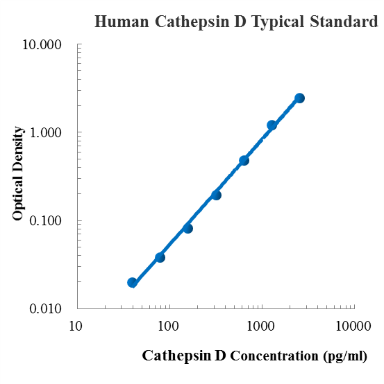
Human Cathepsin D ELISA Kit
$350.00 – $450.00
| Sample Type | Serum, plasma, cell culture supernatant, and other biological samples |
|---|---|
| Sample Volume | 100 μL(diluent) |
| Sensitivity | 5.52 pg/mL |
| Range | 39.06 pg/mL – 2,500 pg/mL |
| Assay Time | 3.5 h |
| Recovery | 90% – 109% |
| Average Recovery | 1.02 |
| Intra Precision | 2.5% – 3.9% |
| Inter-Precision | 2.8% – 4.3% |
| Platform | ELISA |
| Plate | Detachable 96-well plate |
| Size | 96T/48T |
| Storage | If the reagent kit is unopened, it should be stored at 4℃. However, if it has been opened, the standard solution should be stored at -20℃, while the other components should be stored at 4℃. |
| Delivery | 4℃ blue ice transportation |
| Components | 96-well polystyrene enzyme-linked immunosorbent assay (ELISA) plate coated with anti-Human Cathepsin D monoclonal antibody Human Cathepsin D freeze-dried standard Human Cathepsin D detect Antibody Assay Buffer(10×) Substrate TMB Stop Solution Washing Buffer(20×) Sealing Film |
| Assay Principle | This kit utilizes the double antibody sandwich enzyme-linked immunosorbent assay (ELISA) detection technique.Specific anti-human CD30 antibodies are precoated on a high-affinity ELISA plate. Standard samples, test samples, and the detection antibody labeled with horseradish peroxidase are added to the wells of the ELISA plate. After incubation, CD30 present in the samples binds to the solid-phase antibodies and the detection antibodies. After washing, a colorimetric substrate, TMB, is added and the plate is incubated in the dark for color development. The intensity of the color reaction is directly proportional to the concentration of CD30 in the samples.A stop solution is added to terminate the reaction, and the absorbance value is measured at a wavelength of 450 nm (with a reference wavelength range of 570-630 nm). |
Targets
CTSD
CTSD Target Infomation Overview
- Target Symbol: CTSD, cathepsin D
- Gene Groups: Cathepsins; Peptidase family A1
- Alias: CLN10
- Previous Names: CPSD
- Alias Names: ceroid-lipofuscinosis, neuronal 10; cathepsin D (lysosomal aspartyl protease)
CTSD, cathepsin D Target Infomation by Species
[su_tabs][su_tab title=”Human” disabled=”no” anchor=”” url=”” target=”blank” class=”tab-human”]
Human CTSD Target Information
- Target Symbol: CTSD, cathepsin D
- Alias:
- cathepsin d (lysosomal aspartyl protease)
- ceroid-lipofuscinosis, neuronal 10
- CLN10
- CPSD
- epididymis secretory sperm binding protein Li 130P
- HEL-S-130P
- lysosomal aspartyl peptidase
- lysosomal aspartyl protease
- MGC2311
- NCBI_Gene: 1509
- UniProtKB: P07339
Human CTSD Predicted Functions
Enables peptidase activity. Involved in several processes, including lipoprotein catabolic process; positive regulation of apoptotic process; and positive regulation of cysteine-type endopeptidase activity involved in apoptotic process. Located in endosome membrane; lysosomal membrane; and membrane raft. Colocalizes with collagen-containing extracellular matrix. Implicated in Alzheimer’s disease; breast cancer; and neuronal ceroid lipofuscinosis 10. Biomarker of Alzheimer’s disease.
[/su_tab]
[su_tab title=”Mouse” disabled=”no” anchor=”” url=”” target=”blank” class=”tab-mouse”]
Mouse Ctsd Target Information
- Target Symbol: Ctsd, cathepsin D
- Alias:
- CatD
- CD
- NCBI_Gene: 13033
-
- UniprotKB: P18242
- UniprotKB: F8WIR1
- UniprotKB: Q05BF3
- UniprotKB: Q3TIR0
- UniprotKB: Q3TJN3
- UniprotKB: Q3TWD0
- UniprotKB: Q3TWL1
- UniprotKB: Q3TWR6
- UniprotKB: Q3TXL5
- UniprotKB: Q3U651
- UniprotKB: Q3U7I9
- UniprotKB: Q3U7P0
- UniprotKB: Q3U8W5
- UniprotKB: Q3UAQ1
- UniprotKB: Q3UC89
- UniprotKB: Q3UCD9
- UniprotKB: Q3UCW4
Mouse Ctsd Predicted Functions
Enables aspartic-type endopeptidase activity. Acts upstream of or within autophagosome assembly. Located in extracellular space and lysosome. Is expressed in several structures, including central nervous system; extraembryonic component; eye; genitourinary system; and optic nerve. Used to study neuronal ceroid lipofuscinosis 10. Human ortholog(s) of this gene implicated in Alzheimer’s disease; breast cancer; and neuronal ceroid lipofuscinosis 10. Orthologous to human CTSD (cathepsin D).
[/su_tab]
[su_tab title=”Rat” disabled=”no” anchor=”” url=”” target=”blank” class=”tab-rat”]
Rat Ctsd Target Information
- Target Symbol: Ctsd, cathepsin D
- Alias:
- 无
- NCBI_Gene: 171293
Rat Ctsd Predicted Functions
Enables endopeptidase activity and peptide binding activity. Involved in proteolysis and response to nutrient levels. Located in lysosome. Human ortholog(s) of this gene implicated in Alzheimer’s disease; breast cancer; and neuronal ceroid lipofuscinosis 10. Orthologous to human CTSD (cathepsin D).
[/su_tab][/su_tabs]
CTSD Target News
[catlist tags=”ctsd” template=targetnews thumbnail=yes thumbnail_class=”related-post-media clr” thumbnail_size=833]





